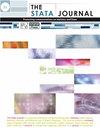扩展的biasplot命令用于评估方法比较研究中的偏差、精度和一致性
IF 3.2
2区 数学
Q1 SOCIAL SCIENCES, MATHEMATICAL METHODS
引用次数: 1
摘要
最近,taff本文章由计算机程序翻译,如有差异,请以英文原文为准。
Extended biasplot command to assess bias, precision, and agreement in method comparison studies
Recently, a new statistical methodology to assess the bias and precision of a new measurement method, which circumvents the deficiencies of the Bland and Altman (1986, Lancet 327: 307–310) limits of agreement method, was developed by Taffé (2018, Statistical Methods in Medical Research 27: 1650–1660). Later, the methodology was extended to assess the agreement. In addition, to allow for inferences, simultaneous confidence bands around the bias, precision, and agreement lines were developed (Taffé, 2020, Statistical Methods in Medical Research 29: 778–796). The goal of this article is to introduce the extended biasplot command, which implements these latest developments, and to illustrate its use by applying it to simulated data included with the command. Note that the Taffé method assumes that there are several measurements by one of the two measurement methods and possibly as few as one measurement by the other for each individual. The repeated measurements need not come from the reference standard but from any of the two measurement methods. This is a great advantage because it may sometimes be more feasible to gather repeated measurements either with the reference standard or the new measurement method.
求助全文
通过发布文献求助,成功后即可免费获取论文全文。
去求助
来源期刊

Stata Journal
数学-统计学与概率论
CiteScore
7.80
自引率
4.20%
发文量
44
审稿时长
>12 weeks
期刊介绍:
The Stata Journal is a quarterly publication containing articles about statistics, data analysis, teaching methods, and effective use of Stata''s language. The Stata Journal publishes reviewed papers together with shorter notes and comments, regular columns, book reviews, and other material of interest to researchers applying statistics in a variety of disciplines.
 求助内容:
求助内容: 应助结果提醒方式:
应助结果提醒方式:


